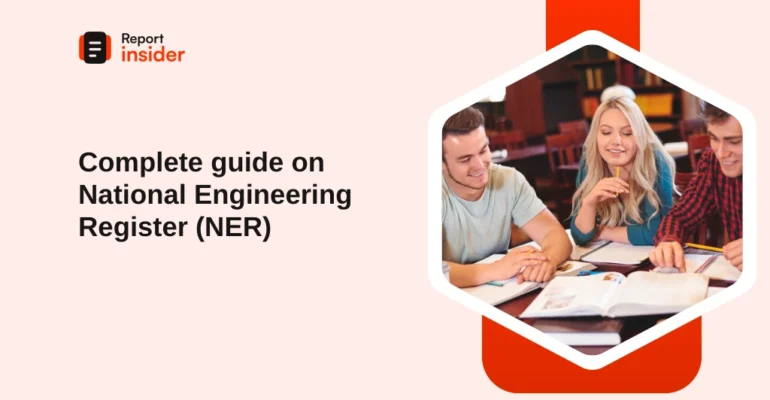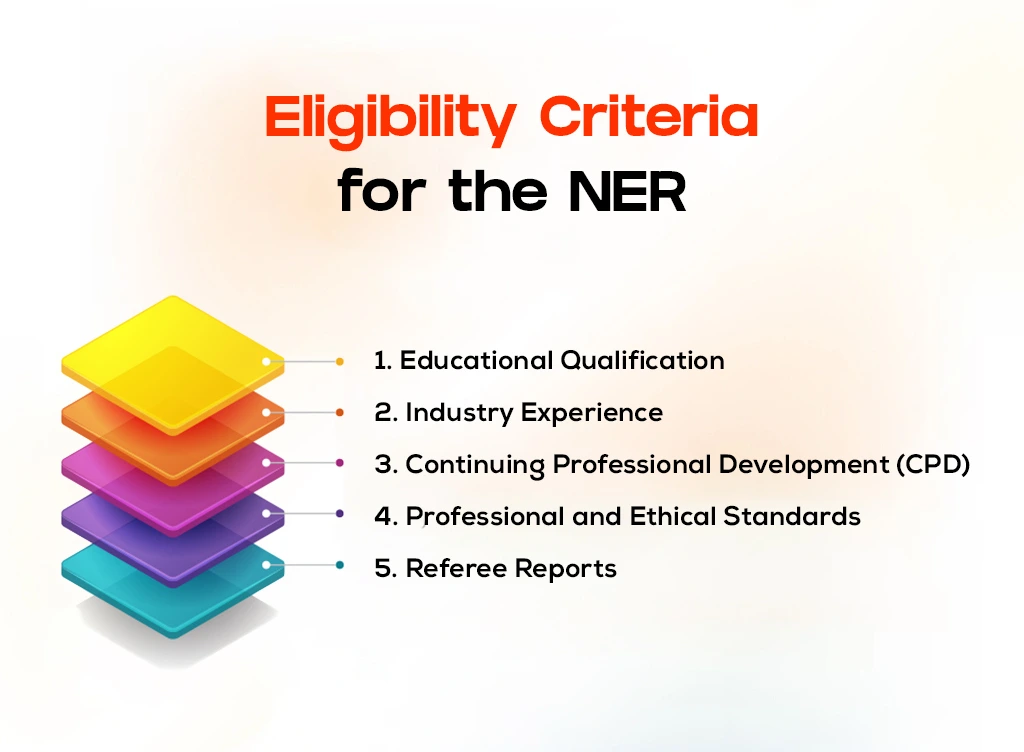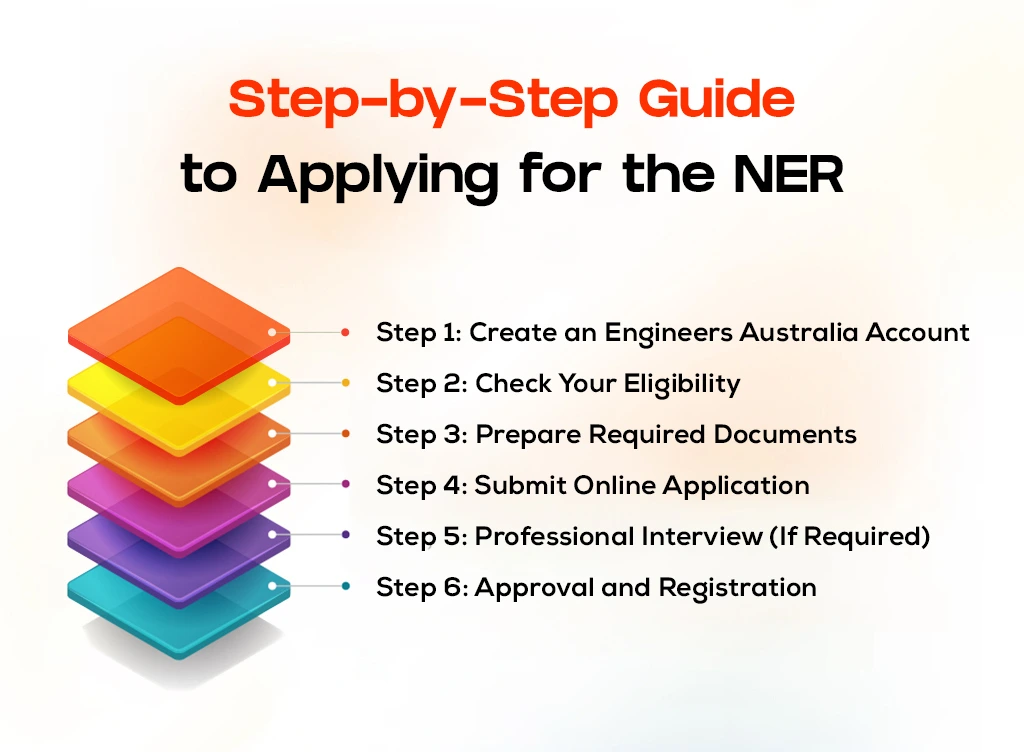Complete guide on National Engineering Register (NER)

Complete guide on National Engineering Register (NER)
The National Engineering Register (NER) from Engineers Australia presents a robust credential that documents both your engineering expertise and your professional ethics and your dedication to ongoing growth.
The guide provides a complete breakdown of details for those who want to add NER accreditation to their engineering resume or require it for visa and migration requirements in Australia’s competitive engineering job arena.
🔑 Key Highlights
- National Recognition: The NER’s main benefits include the recognition of your skills, ethics and credibility.
- Career Boost: The NER Register enhances the chance of getting a job, and employers become more confident in the candidates.
- Chartered Pathway: The NER assists in consolidating the requisite knowledge and skills that lead to attaining the status of a Chartered Engineer (CPEng).
- Global and Industry Trust: It has in addition, created a viral recognition and client assurance.
What is the National Engineering Register (NER)?
The National Engineering Register (NER) is a publicly available register of employers, clients, and government agencies to which they turn to validate the credentials of engineers in different disciplines. Registration on the NER shows that an engineer:
- Meets industry-recognised competency standards
- Qualified and has practical experience.
- Complies with continuing professional development (CPD) requirements
- It is committed to professional accountability and the safety of the public.
NER registration is beneficial to engineers wishing to improve career prospects, establish themselves professionally or become eligible for government and defence contracts. It also plays a key role in skilled migration applications where engineering expertise is to be formally recognised.
Why is the NER important?

Professional recognition, along with career advancement and industry credibility, depends heavily on the National Engineering Register. Here’s why it matters:
1. Recognition of Competence
Becoming listed on the National Engineering Register (NER) certifies an engineer’s technical proficiency and their moral character. The professional assessment process confirms the qualifications and work experience and professional conduct of engineers who earn this status.
This achievement demonstrates successful completion of the required engineering criteria according to national standards, thus making professionals attractive in today’s competitive occupational landscape.
2. Enhanced Career Opportunities
Engineers who appear on the NER benefit substantially from job application processes because government roles and important infrastructure positions prefer their membership. Employers choose qualified candidates from NER to verify their demonstrated skills and professional adherence to standards through the registry system. When engineers place themselves on the register, they become more noticeable in competitive fields and improve their prospects of obtaining senior role opportunities.
3. Pathway to Chartered Status
Engineers often see the NER as the starting point on their journey towards gaining CPEng status, representing Australia’s top engineering designation. NECTA membership establishes professional competency while advancing skill development that helps applicants reach CPEng certification more easily.
For aspiring leaders and international engineers who aim to achieve chartered status, the NER provides an essential pathway of advancement.
4. Global Mobility
Engineering professionals who aim to work outside their home country find that the NER significantly increases their professional value. The NER links Australian engineering standards with international competency standards, which enables engineers to show foreign employers that their qualifications hold value on a professional level.
Engineers gain attractiveness as global candidates for multinational firms and international projects through the NER, which displays their educational background alongside professional history and ethical principles.
5. Consumer and Employer Confidence
Trust stands as a fundamental principle in engineering professional services because the NER operates to develop this mutual trust between engineers and their client base. The national register, which Engineers Australia monitors, creates confidence among stakeholders that they hire qualified engineers who work with professional ethics.
Engineers with confidence from their NER listing generate stronger working connections, which secure project work opportunities while earning repeat engagements in both consultancy and contract-based fields.
Eligibility Criteria for the NER

NER registration requirements include engineers fulfilling the following conditions:
1. Educational Qualification
Applicants need to hold an engineering degree approved by an accredited institution in addition to getting their degree from an institution recognised for accreditation purposes. This includes:
Engineers seeking to become professionals can earn their qualifications through a 4-year Bachelor of Engineering (Honours) programme.
The engineering technologist position requires completion of a 3-year Bachelor of Engineering Technology programme.
A 2-year diploma or advanced diploma in engineering awards the professional certification of engineering associate.
2. Industry Experience
Engineers must prove five consecutive years of engineering work experience in their last decade.
The applicant needs to show a combination of technical abilities, problem-solving experience and leadership activities.
3. Continuing Professional Development (CPD)
Engineering professionals need to demonstrate 150 hours of continuing professional development activities throughout their last three years of practice.
Engineers must participate in four types of CPD activities, including formal learning as well as conferences, self-directed study and mentoring.
4. Professional and Ethical Standards
Engineers Australia requires its members to comply with its professional code.
Proof of excellent professional decision-making, risk evaluation and adherence to ethical standards must be shown by candidates.
5. Referee Reports
Each application must include at least two professional referee reports submitted by supervisors, colleagues, or clients who have experience verifying the applicant’s engineering work.
Step-by-Step Guide to Applying for the NER

A detailed guide to applying for the NER presents the following steps in sequence.
Step 1: Create an Engineers Australia Account
You must first create an account through Engineers Australia’s website (EA) if you do not hold membership.
Step 2: Check Your Eligibility
Before you can apply for this position, you must show proof of meeting the specified educational standards and professional experience alongside required continuing professional development activity and adherence to ethical principles.
Step 3: Prepare Required Documents
Gather the following:
The professional resume should include detailed descriptions of your workplace projects.
The work experience statement provides an in-depth review of your career, including your involvement with engineering projects and complete responsibility situations, along with your technological contributions.
Your submission for CPD must demonstrate 150 hours of active professional development participation.
Two referee reports should include professional verification of your work from industry experts.
Step 4: Submit Online Application
Visit the NER section at Engineers Australia’s website platform.
Use the application portal to complete the requested form, then upload your required documents.
Prospective applicants must pay fees of $245 to EA members and $365 to non-members during the submission process.
Step 5: Professional Interview (If Required)
Engineers Australia assessors require online professional interviews with certain applicants seeking registration. During the interview, assessors will evaluate your technical expertise and professional ethics, together with your work experience.
Step 6: Approval and Registration
Getting approval will add your name to the National Engineering Register, where you’ll also receive an official NER certificate.
What are the benefits of being on NER?

The benefits of being on NER are as follows:
1. Career Advancement
Registration in the National Engineers Registry provides engineers with substantial career benefits that help their professional path move upward. When employers see your name on the NER database, they understand that you fulfil the national criteria for competence, together with professional ethics and professional behaviour. Job applications and promotions, alongside internal transfer opportunities, strongly benefit from this registration.
Professional talent status as an NER-registered individual appeals to employers who work in public sector agencies, infrastructure companies, and multinational engineering consultancies since it minimises their employment security concerns about hiring unexamined personnel. The registration process lets you join advanced, significant development work, which creates an enduring basis for your professional career advancement.
2. Higher Earning Potential
Being part of the NER enables professionals to earn more money. NER listing increases engineers’ bargaining power when negotiating salary because it formally acknowledges their skills and experience.
NER-listed professionals stand a higher chance of qualifying for team leadership roles and project management positions, and senior consultant positions that automatically result in greater earning potential. Organisations value NER verifications because they gain confidence in their candidates’ expert skills and reliability, which leads them to offer increased remuneration.
3. Global Recognition
Engineers throughout today’s interconnected world maintain international projects and overseas relocation as major career objectives. The NER supports worldwide employee movement through its participation with the Washington Accord, Sydney Accord and Dublin Accord international standards.
The agreements promote qualification and competency recognition between member countries of multinational organisations. Australian engineers who become members of the NER face smoother recognition processes across countries such as the UK, the USA, Canada, New Zealand and other international territories.
4. Business and Consultancy Opportunities
Registration on the NER provides significant brand value to self-employed engineers as well as professionals who operate consultancy businesses. NSE listing functions as official recognition of your engineering abilities and professional ethics standards, leading to increased client acquisition opportunities for contracts.
Engineering clients with technical limitations prefer working with professionals listed in the professional national registry due to its curated status. The direct result of joining the NER is more business opportunities alongside bigger contracts, which establish enduring partnerships.
5. Pathway to Chartered Status
The NER benefits users by establishing a straightforward process that leads to the Chartered Professional Engineer (CPEng) professional status achievement. Foundation competence at the NER does not match the ultimate engineering professional benchmark that chartered status provides in both Australian and international markets.
Engineers use NER registration as an introductory point towards their professional development because it helps engineers better understand chartered processes, which simplifies their path to CPEng certification over time. Professional advancement into executive positions and project management leadership roles, as well as thought leadership opportunities within industries, becomes accessible through chartered status.
Conclusion
The evolving engineering field demands professional standards together with accountability and verified expertise, so the National Engineering Register (NER) emerges as an essential credential for Australian engineers. NER status transcends basic listing to function as an open declaration of your technical mastery, coupled with your moral responsibility and ongoing skill improvement.
NER registration benefits engineers at all professional levels, from early career phases to established experts who seek to enhance their reputation. Your job opportunities will expand dramatically when you become visible to employers and fulfil the requirements for both government and advanced private projects, alongside gaining higher opportunities to reach leadership positions or consulting positions. This certification establishes a respected professional identity that domestic employers alongside organisations from worldwide locations recognise and respect.
FAQs
1. Is it easy to get NER?
If you meet the experience, qualifications and CPD requirements, it can be achievable.
2. How long does it take to get NER?
It typically takes 4 to 8 weeks to get NER.
3. What is NER?
The National Engineering Register (NER) is an official list maintained by Engineers Australia that recognises qualified, experienced, and ethically responsible engineers across various disciplines.
4. How do I get the NER certificate?
To obtain the NER certificate, apply through Engineers Australia by submitting your qualifications, work experience, CPD records, and proof of professional indemnity insurance. Upon successful assessment, you’ll receive your NER certificate.

